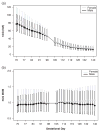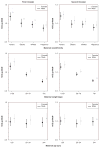Fetal sex differences in human chorionic gonadotropin fluctuate by maternal race, age, weight and by gestational age
- PMID: 26242396
- PMCID: PMC4625920
- DOI: 10.1017/S2040174415001336
Fetal sex differences in human chorionic gonadotropin fluctuate by maternal race, age, weight and by gestational age
Abstract
Circulating levels of the placental glycoprotein hormone human chorionic gonadotropin (hCG) are higher in women carrying female v. male fetuses; yet, the significance of this difference with respect to maternal factors, environmental exposures and neonatal outcomes is unknown. As a first step in evaluating the biologic and clinical significance of sex differences in hCG, we conducted a population-level analysis to assess its stability across subgroups. Subjects were women carrying singleton pregnancies who participated in prenatal and newborn screening programs in CA from 2009 to 2012 (1.1 million serum samples). hCG was measured in the first and second trimesters and fetal sex was determined from the neonatal record. Multivariate linear models were used to estimate hCG means in women carrying female and male fetuses. We report fluctuations in the ratios of female to male hCG by maternal factors and by gestational age. hCG was higher in the case of a female fetus by 11 and 8% in the first and second trimesters, respectively (P<0.0001). There were small (1-5%) fluctuations in the sex difference by maternal race, weight and age. The female-to-male ratio in hCG decreased from 17 to 2% in the first trimester, and then increased from 2 to 19% in the second trimester (P<0.0001). We demonstrate within a well enumerated, diverse US population that the sex difference in hCG overall is stable. Small fluctuations within population subgroups may be relevant to environmental and physiologic effects on the placenta and can be probed further using these types of data.
Keywords: placental hormones; pregnancy; sexual dimorphism.
Conflict of interest statement
None.
Figures



References
-
- Bremme K, Lagerström M, Andersson O, Johansson S, Eneroth P. Influences of maternal smoking and fetal sex on maternal serum oestriol, prolactin, hCG, and hPI levels. Arch Gynecol Obstet. 1990;247:95–103. - PubMed
-
- Clements JA, Reyes FI, Winter JS, Faiman C. Studies on human sexual development. III. Fetal pituitary and serum, and amniotic fluid concentrations of LH, CG, and FSH. J Clin Endocrinol Metab. 1976;42:9–19. - PubMed
-
- Cowans NJ, Stamatopoulou A, Maiz N, Spencer K, Nicolaides KH. The impact of fetal gender on first trimester nuchal translucency and maternal serum free beta-hCG and PAPP-A MoM in normal and trisomy 21 pregnancies. Prenat Diagn. 2009;29:578–581. - PubMed
-
- Steier JA, Myking OL, Bergsjo PB. Correlation between fetal sex and human chorionic gonadotropin in peripheral maternal blood and amniotic fluid in second and third trimester normal pregnancies. Acta obstetricia et gynecologica Scandinavica. 1999;78:367–371. - PubMed
-
- Yaron Y, Lehavi O, Orr-Urtreger A, et al. Maternal serum HCG is higher in the presence of a female fetus as early as week 3 post-fertilization. Hum Reprod. 2002;17:485–489. - PubMed
Publication types
MeSH terms
Substances
Grants and funding
LinkOut - more resources
Full Text Sources
Research Materials

